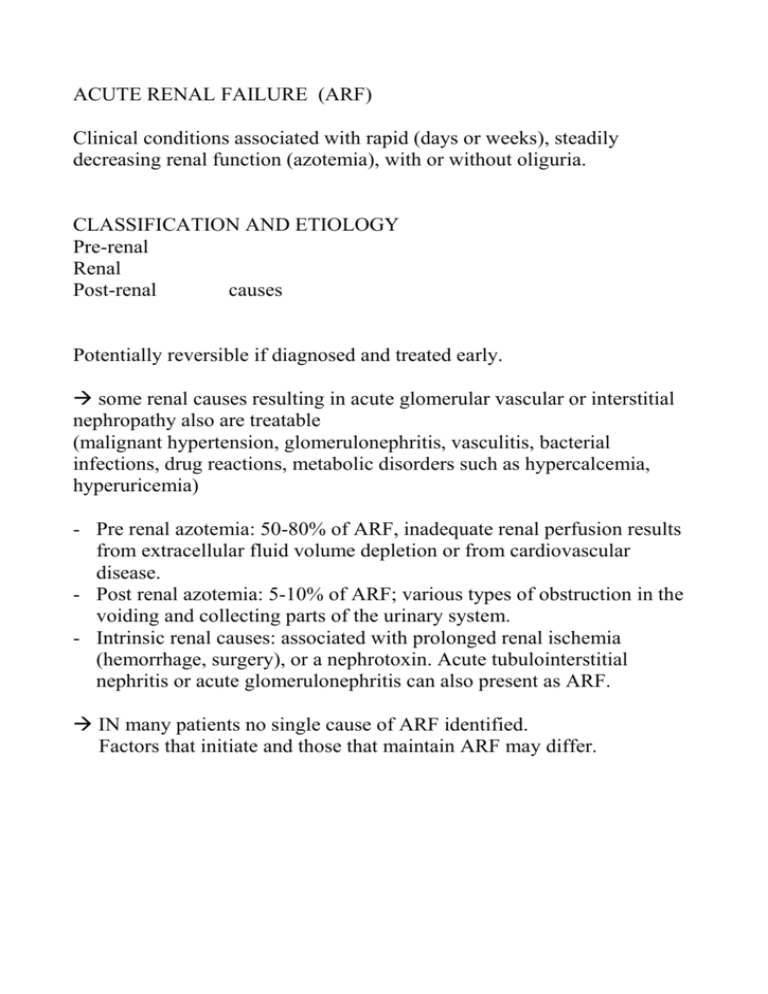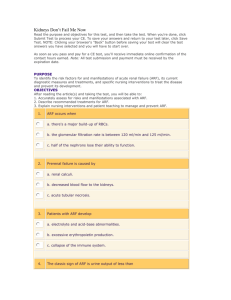ACUTE RENAL FAILURE (ARF)
advertisement

ACUTE RENAL FAILURE (ARF) Clinical conditions associated with rapid (days or weeks), steadily decreasing renal function (azotemia), with or without oliguria. CLASSIFICATION AND ETIOLOGY Pre-renal Renal Post-renal causes Potentially reversible if diagnosed and treated early. some renal causes resulting in acute glomerular vascular or interstitial nephropathy also are treatable (malignant hypertension, glomerulonephritis, vasculitis, bacterial infections, drug reactions, metabolic disorders such as hypercalcemia, hyperuricemia) - Pre renal azotemia: 50-80% of ARF, inadequate renal perfusion results from extracellular fluid volume depletion or from cardiovascular disease. - Post renal azotemia: 5-10% of ARF; various types of obstruction in the voiding and collecting parts of the urinary system. - Intrinsic renal causes: associated with prolonged renal ischemia (hemorrhage, surgery), or a nephrotoxin. Acute tubulointerstitial nephritis or acute glomerulonephritis can also present as ARF. IN many patients no single cause of ARF identified. Factors that initiate and those that maintain ARF may differ. PATHOPHYSIOLOGY PRE-RENAL: Oliguria (urine <500 ml/day) from reduced GFR and enhanced Na+ and H2O reabsorbtion, a normal response to ineffective circulating blood volume. POST-RENAL: Bladder outlet obstruction most common cause (prostatic hyperplasia, cancer of prostate or cervix, retroperitoneal disorders). Occlusion of both urinary outflow tracts. Less frequent intraluminal causes: bilateral renal calculi, papillary necrosis, coagulated blood, bladder carcinoma. Extraluminal causes: retroperitoneal fibrosis, colorectal tumor, neoplasia. In children: congenital obstructive defects. RENAL: Hypofiltration includes decrease in renal blood flow, reduced glomerular permeability, tubular obstruction, injured tubular epithelium. (Variability in factors, inadequacy of former term “acute tubular necrosis”) Renal vasculature very sensitive to endothelin antiendothelin antibodies or endothelin-receptor antagonists may protect against ischemic ARF Structura changes in the tubules depend on the insult, edema and inflammation always present. ARF accompanied by hypocalcemia, hyperphosphatemia and secondary hyperparathyroidism. Temporary loss of calcitriol production by the injured kidney and phosphate retention SYMPTOMS AND SIGNS - In community acquired ARF often only finding is passage of colacolored urine followed by oliguria or anuria. - In hospitalized patients: recent traumatic, surgical or medical event - A relatively preserved urine output (1-2.4 l/day) common. Oliguria may occur. Anuria suggests bilateral renal artery occlusion, obstructive uropathy, acute cortical necrosis, rapidly progressive glomerulonephritis - Intrinsic renal disease: 3 phases. prodromal phase (depends on cause) Oliguric phase 10-14 days, Urine output 50-400 mL/day (non oliguric patients better prognosis). Serum creatinine typically increases by 1-2 mg/dL/day and urea nitrogen by 10-20 mg/dL Urea nitrogen may be misleading as an early index of renal function (elevated by increased proteine catabolism). Postoliguric phase: urine output gradually back to normal, but serum creatinine and urea levels may not fall for several days. Tubular dysfunction may persists (Na wasting, polyuria, hyperchloremic metabolic acidosis) - Glomerulonephritis suggested by edema, nephrotic syndrome, signs of arteritis in the skin and retina - Hemoptysis suggests Wegener’s granulomatosis or Goodpasture’s syndrome - Skin rash suggests polyarteritis or SLE. DIAGNOSIS - Progressive daily rise in serum creatinine diagostic of ARF. - Improvement by correction of hemodynamic abnormality (Pre-renal) - Urinary and serum chemical analysis renal failure index renal failure index: Urine NA / U/P creatinine ratio - Recommended blood tests: creatinine, CO2, K+, serum Na++, Ca++, Phosphate, BUN, uric acid, CK, Antistreptolysin-O and complement titres, antinuclear antibodies, antinuclear cytoplasmic antibodies, Urine Na and creatinine, blood and urine cultures. - Typical laboratory findings: progressive azotemia, acidosis (moderate, plasma CO2 12-20 mmol/L) , hyperkalemia, hyponatremia (surplus of water), normochromic, normocytic anemia. - Urinary sediment: WBCs, RBDs, casts (granular and tubular cells). In primary renal injury tubular cells, tubular cells casts, brown granular casts - X-ray abdomen: 90% urinary calculi (radiopaque) - Ultrasonography (sensitivity 80-85%) - If obstruction suspected, antegrade or retrograde contrast studies - Post-voiding urethral catheterization - Ultrasonography or CT: a normal or enlarged kidney favours reversibility, whereas small sizes suggest chronic renal insufficiency - Renal arteriography or venography - MRI if radiocontrast dangerous - Radionuclide studies only to exclude renal artery occlusion - Renal biopsy if cause elusive. PROGNOSIS ARF and complications (hypervolemia, metabolic acidosis, hyperkalemia, uremia, bleeding diathesis) treatable, but survival 60% PROPHYLAXIS AND TREATMENT Prevention by: - maintenance of normal fluid balance, blood volume, and BP during and after major surgery - isotonic NaCl infusions in patients with severe burns, - prompt transfusions in hemorrhagic hypotension Vasopressor drug: dopamine 1-3 mcg/Kg/min I.V. may augment renal blood flow and urine output Incipient ARF: furosemide with mannitol or dopamine may reestablish normal urine output Dehydration and ECF depletion should be avoided in patients with cholecystography or in renal insuff patients requiring urography (mainly if with multiple myeloma). Urography and angiography should be avoided in patients with renal insufficiency because of high incidence of renal deterioration. Before cytolitic therapy in patients with lymphoma or leukemia treatment with allopurinol along with alkalizing urine (Na bicarbonate or acetazolamide) and increasing urine flow with increased oral or IV fluids to reduce urate crystalluria. DIALYSIS Improves fluid and electrolyte imbalance. Allows adequate nutrition. ARF should be managed without dialysis only when dialysis unavailable or ARF uncomplicated and existed < 5 days. Water intake restricted to a volume equal to urine output + measured extrarenal losses + 500 ml/day for insensible loss. Body weight is an indicator of fluid intake. To reduce nitrogen loss oral of IV essential amino acids with glucose To keep serum K+ < 6 mmol/L in the absence of dialysis , cationexchange resin (sodium polystyrene sulfonate) 15 g PO or rectally 1-4 times /day. When obstruction is relieved polyuria with escretion of large amounts of Na, K, Mg. Possible contraction of ECF volume with vascular collapse may occur IN the post oliguric phase close attention to fluid and electrolyte balance is mandatory.







